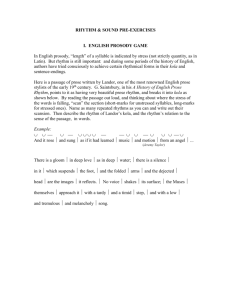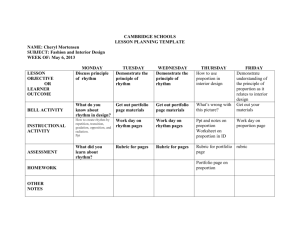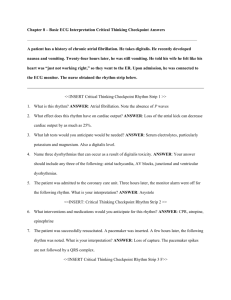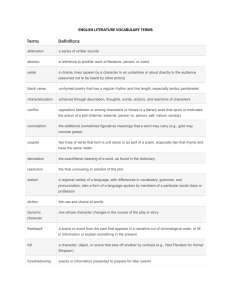04 Rhythm in General
advertisement
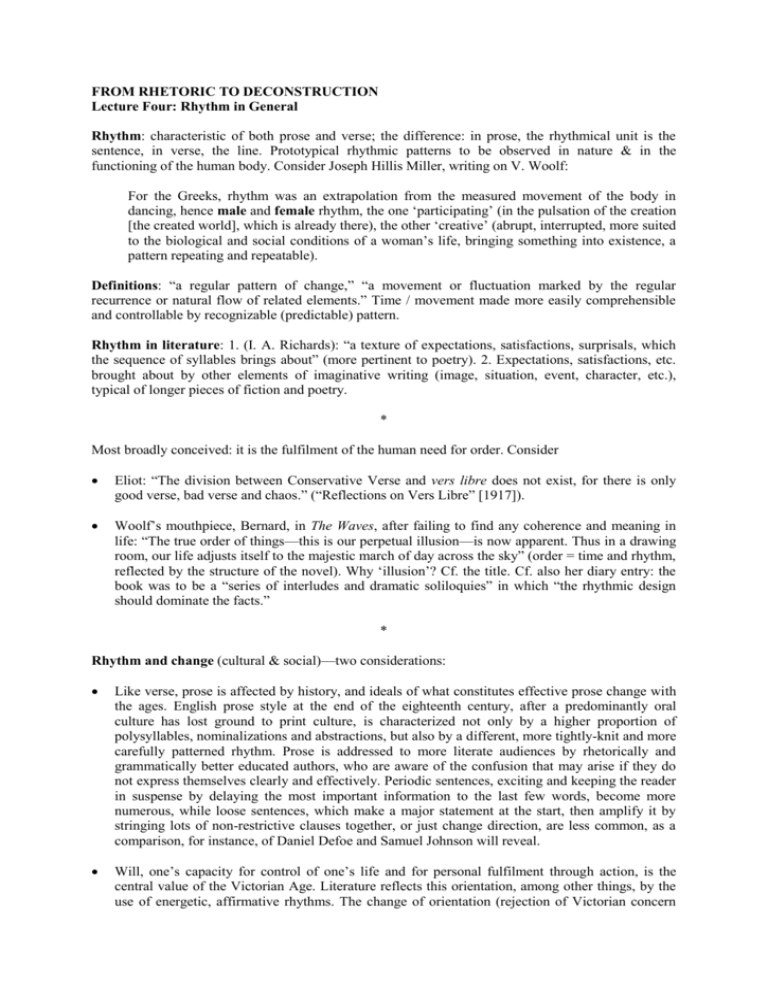
FROM RHETORIC TO DECONSTRUCTION Lecture Four: Rhythm in General Rhythm: characteristic of both prose and verse; the difference: in prose, the rhythmical unit is the sentence, in verse, the line. Prototypical rhythmic patterns to be observed in nature & in the functioning of the human body. Consider Joseph Hillis Miller, writing on V. Woolf: For the Greeks, rhythm was an extrapolation from the measured movement of the body in dancing, hence male and female rhythm, the one ‘participating’ (in the pulsation of the creation [the created world], which is already there), the other ‘creative’ (abrupt, interrupted, more suited to the biological and social conditions of a woman’s life, bringing something into existence, a pattern repeating and repeatable). Definitions: “a regular pattern of change,” “a movement or fluctuation marked by the regular recurrence or natural flow of related elements.” Time / movement made more easily comprehensible and controllable by recognizable (predictable) pattern. Rhythm in literature: 1. (I. A. Richards): “a texture of expectations, satisfactions, surprisals, which the sequence of syllables brings about” (more pertinent to poetry). 2. Expectations, satisfactions, etc. brought about by other elements of imaginative writing (image, situation, event, character, etc.), typical of longer pieces of fiction and poetry. * Most broadly conceived: it is the fulfilment of the human need for order. Consider Eliot: “The division between Conservative Verse and vers libre does not exist, for there is only good verse, bad verse and chaos.” (“Reflections on Vers Libre” [1917]). Woolf’s mouthpiece, Bernard, in The Waves, after failing to find any coherence and meaning in life: “The true order of things—this is our perpetual illusion—is now apparent. Thus in a drawing room, our life adjusts itself to the majestic march of day across the sky” (order = time and rhythm, reflected by the structure of the novel). Why ‘illusion’? Cf. the title. Cf. also her diary entry: the book was to be a “series of interludes and dramatic soliloquies” in which “the rhythmic design should dominate the facts.” * Rhythm and change (cultural & social)—two considerations: Like verse, prose is affected by history, and ideals of what constitutes effective prose change with the ages. English prose style at the end of the eighteenth century, after a predominantly oral culture has lost ground to print culture, is characterized not only by a higher proportion of polysyllables, nominalizations and abstractions, but also by a different, more tightly-knit and more carefully patterned rhythm. Prose is addressed to more literate audiences by rhetorically and grammatically better educated authors, who are aware of the confusion that may arise if they do not express themselves clearly and effectively. Periodic sentences, exciting and keeping the reader in suspense by delaying the most important information to the last few words, become more numerous, while loose sentences, which make a major statement at the start, then amplify it by stringing lots of non-restrictive clauses together, or just change direction, are less common, as a comparison, for instance, of Daniel Defoe and Samuel Johnson will reveal. Will, one’s capacity for control of one’s life and for personal fulfilment through action, is the central value of the Victorian Age. Literature reflects this orientation, among other things, by the use of energetic, affirmative rhythms. The change of orientation (rejection of Victorian concern Lecture Four: Rhythm in General 2 with material things) at the end of the nineteenth century is accompanied by change in style and rhythm. As Yeats wrote, we would cast out of serious poetry those energetic rhythms, as of a man running, which are the inventions of the will with its eyes always on something to be done or undone; and we would seek out those wavering, meditative, organic rhythms, which are the embodiment of the imagination, that neither desires nor hates because it has done with time, and only wishes to gaze upon some reality, some beauty. (“The Symbolism of Poetry” [1900]) Rhythm philosophically—Yeats and Eliot: The purpose of rhythm, it has always seemed to me, is to prolong the moment of contemplation, the moment when we are both asleep and awake, which is the one moment of creation, by hushing us with an alluring monotony, while it holds us waking by variety, to keep us in that state of perhaps real trance. (Yeats, “The Symbolism of Poetry”). “Only by the form, the pattern / Can words and music reach / The stillness” (stillness = eternity = God) (Eliot, Four Quartets). The same in his essay, “Poetry and Drama”: verse drama, by imposing order upon reality, elicits some perception of order from reality; his own plays as evidence. * Rhythm in prose as well as in verse has a mimetic and also an expressive function. From the point of view of the speaker, the two functions coincide (rhythm reflects as well as expresses the speaker’s state of mind). This is an inherent quality of language, as Plato already well knew. As in Book III of The Republic his mouthpiece Socrates the philosopher explains, “grace or the absence of grace is an effect of good or bad rhythm,” and “beauty of style and harmony and grace and good rhythm depend on simplicity, [. . .] the true simplicity of a rightly and nobly ordered mind and character.” The mimetic and expressive in literary prose—consider the appeal of language to Stephen Dedalus in Joyce’s A Portrait of the Artist as a Young Man (1916): Words. Was it their colours? He allowed them to glow and fade, hue after hue: sunrise gold, the russet and green of apple orchards, azure of waves, the grey-fringed fleece of clouds. No, it was not their colours: it was the poise and balance of the period itself. Did he then love the rhythmic rise and fall of words better than their associations of legend and colour? Or was it that, being as weak of sight as he was shy of mind, he drew less pleasure from the reflection of the glowing sensible world through the prism of a language many-coloured and richly storied than from the contemplation of an inner world of individual emotions mirrored perfectly in a lucid supple periodic prose? The styles of the episodes are shaped by this consideration. Periodic, as is borne out by most of the novel, implies the use of rhythm which, although it creates suspension and surprise, moves forward at a more or less even pace. Yet when in the climactic scene a highly agitated Stephen meets a girl whom his imagination transforms into a personification of the aesthetic idea of beauty, there is a change of style. Through the use of rhetorical devices for repetition (employing the figures of epanodos and chiasmus), the rhythm suggests that time in those visionary moments of great intensity has ceased to matter to the young man. “Her bosom was as a bird’s, soft and slight, slight and soft as the breast of some dark-plumaged dove. But her long fair hair was girlish: and girlish, and touched with the wonder of mortal beauty, her face.” Language by the change of style performs a double task: it represents what Stephen is experiencing; at the same time, it expresses how he is responding to that experience.
